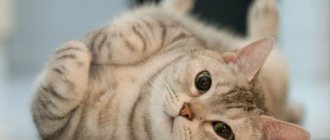Hi all!
The first day of calendar spring has arrived, and with it Cat Day, which has been falling on March 1 in Russia for several years now. On the eve of last March, a note has already appeared on this blog about yard cats and street cats. Why not continue the topic and talk about how a cat lived with a person, how it was treated at different times, and how Cat Day is celebrated in different countries today.
Man and cat: the beginning of a relationship
It is believed that domestic cats have lived next to humans for thousands of years. Thus, during archaeological excavations in Cyprus, cat bones were discovered next to human burials dating back to the 8th millennium BC. However, the question of how the cat managed to tame humans still remains open.
People put forward a version according to which the development of agriculture by man and his need to preserve the harvest made the symbiosis of man and cat inevitable. This idea has been repeatedly voiced in various variations by human historians. There is an opinion that cats began to settle near human habitation on their own - there was always enough scraps around it, sufficient to feed a small animal. Then, having introduced toxoplasma into the human body, which causes its carriers to develop an extraordinary attachment to felines, cats literally subjugated humans for a long time. I would like to hear the cats’ opinion on this matter, but for many centuries they have preferred not to discuss this topic.
The mass cult of cats began with the Egyptians, who revered this animal as sacred. On Wikipedia you can find information that the heyday of veneration occurred during the XXII dynasty of the pharaohs (X century BC), but more ancient references are also known (during the reign of Amenemhat I in the XX century BC)
A cat in Ancient Egypt was protected by the state; an attempt on its life was considered a serious crime. The deprivation of a cat's life was punished severely; the offender was subjected to public flogging, property was taken away and even executed if the victim was a palace or temple cat. When a cat died a natural death, the people she lived with observed 70 days of mourning for her, shaving off their eyebrows as a sign of the loss. The cult animal itself was burned or embalmed (Egyptologists discovered numerous mummies of cats and special crematoria for them).
The ancient Egyptian goddess Bast, the daughter of the Sun and the Moon, depicted as a cat or a woman with a cat's head, was considered the goddess of fertility, female beauty, hearth and, of course, the patroness of all cats. She was elevated to the rank of a national deity, with her own temple in which even the pharaohs performed sacrifices.
A cat had its day in Ancient Egypt. Herodotus’ story has reached our time about the honoring of the cat-goddess Bast and a magnificent festival at which “they drink more grape wine than in the rest of the year.” The scale of the cat festival can be indirectly judged by the number of people gathered by Herodotus - “up to 700,000 people of both sexes, not counting children.”
From Egypt, cats, thanks to the Phoenicians, came to Greece, where they also enjoyed universal love. And from there the triumphant campaign to “conquer” the world began. The cat settled and took root everywhere, and she was welcome everywhere.
But it just so happened that the centuries-old history of the relationship between man and cat was not always exclusively white and fluffy. There are also dark spots in this story.
"Cat's story" - from antiquity to the present day
Historians do not know exactly how many years a domestic cat lives next to a person. This proud animal was first tamed by the Egyptians 6-9 thousand years ago. In Ancient Egypt, cats were considered the embodiment of the fertility goddess Bastet and were revered as sacred animals: the punishment for killing a cat was death. These animals were even buried in the same way as noble people - they were mummified.
The fertility goddess Bastet was represented by the ancient Egyptians in the form of a cat.
Together with the Phoenicians, the first tailed creatures from Egypt came by sea to Rome and Greece, from there they went to the territories of modern England and Georgia and further to Europe. In the myths of different peoples, these animals appeared as companions of the gods: in Rome they accompanied the patroness of hunting, Diana; among the Scandinavians, they were the personification of love and fertility, Freya.
In Norse mythology, the goddess Freya rode a chariot drawn by cats.
However, everything did not always go so smoothly: later, in medieval Europe, cats began to be considered accomplices of witches and evil spirits and were burned at the stake. There were even barbaric methods of treatment through burning black cats in iron cages - for example, this was supposed to alleviate the suffering of patients with “St. Vitus’s dance” (epilepsy).
It must be said that Europe paid for the extermination of a huge number of cats by increasing the scale of the “Black Death” epidemics, when, due to the absence of these animals, rodents carrying plague fleas proliferated.
Universal love came to cats in Europe only during the Renaissance - the heyday of science and art.
During the Renaissance, attitudes towards cats changed again, they began to be loved and praised for their gracefulness
In Asia, cats first appeared in China, from where they later moved to Japan, where over the years they acquired the status of one of the most revered animals. It is believed that the first cats arrived in the Land of the Rising Sun during the Nara period - in the 6th century BC. e. with the Chinese ships on which they were taken to guard the sacred Buddhist books.
Photo gallery: the origins of Japanese love for cats in engravings
Cats in Japan were treated very respectfully, here they were equated with titled persons. The first cats brought to Japan were white, which is how they are depicted in most old engravings
An old Japanese print, “A woman cuts off the hem of her kimono so as not to wake the cat,” confirms that cats were highly revered
In our area - in Rus' - cats appeared in the 7th century BC. e. They arrived with merchants as an overseas curiosity, salvation from mice. Russian purrs of that time were domestic helpers, security guards and very expensive and valuable property. It took almost nine hundred years for mustachioed mousecatchers to become available to people with little income.
Cat Alabrys is the hero of Russian folk stories, emphasizing his intelligence, resourcefulness and dexterity in catching mice.
As you may have noticed, the main “duty” of cats has always been to protect valuable books, supplies and crops from rodents. Much later, people paid attention to their personal qualities. Nowadays, the hunting functions of cats have faded into the background, and people have appreciated the variety of colors of the soft skin, the proud, but at the same time loyal to humans character and the soothing purring that creates comfort in the home.
Innocent Victims: The Holy Inquisition and Modernity
The so-called “fight against heresy”, which was widespread in European countries during the heyday of the Holy Inquisition, accompanied by mass pogroms, legalized torture and public executions of many innocent people, is known to every history textbook. The past suffering of cats for the sins attributed to them by the Roman Catholic Church at a time when protecting animals became a fashionable trend is not often remembered.
In 1344, the French town of Metz was struck by an epidemic of chorea, a mental illness called the dance of St. Vitus, more than a thousand people “danced” in the streets for days on end and showed disorderly physical activity, allegedly caused by demons in cat form that had taken possession of them. The exact reasons for this phenomenon are still not known, but what happened then impressed the townspeople so much that over the next 400 years, residents of Metz celebrated Cat Day by annually burning 13 cats and cats in an iron cage in the main square.
The mass extermination of cats was started by Pope Innocent VIII himself, who declared in 1484 that cats are “ pagan beasts in league with the devil.”
" Church representatives explained to parishioners that “witches turn into black cats in order to do dark things under the cover of darkness and meet with the demon.” In this light, even the usual hunt of cats for mice began to be interpreted as nothing other than the devil’s hunt for human souls. So in Western Europe, difficult times came for cats, when the torture and destruction of “satanic spawn” by conscientious citizens became legalized and commonplace. No one could have imagined that several centuries later International Cat Day would be established.
The love of felines for night walks, their silent steps and pupils glowing brightly in the dark played a cruel joke on cats. They were everywhere, without trial or investigation, drowned in sacks, strangled, quartered, burned in cages made of willow twigs, thrown from towers and high walls. Of course, black cats got it more than others. Only a white spot on the fur could save a black cat from imminent death, which was often interpreted as the “mark of an angel”, capable of ridding the animal of suspicions of witchcraft.
Looking through online publications about the times of cat genocide, I have repeatedly come across the opinion that the almost complete destruction of urban cats in the Middle Ages was one of the reasons for the spread of the plague, brought with rats to European port cities by merchant ships. There was no one left to fight the rapidly growing populations of disease-carrying rodents in cities, and the epidemics that struck cities one after another became a punishment for human stupidity and hard-heartedness.
In Western Europe, almost everywhere, cats have become victims of prejudice and cruel traditions. For example, in Pomerania and Bohemia they were buried in the fields to “protect” the crop from pests. In England, live cats were walled up in the foundations of buildings to prevent mice and rats from living in the premises. During the reconstruction of the Tower of London, a dried up and mummified cat was found, which was embedded in the stonework by the builders.
The well-deserved love for cats returned only during the Renaissance; the animal again attracted close attention - this time from scientists, artists, sculptors, and writers. Then the man actively began breeding new breeds of cats, of which more than a hundred have now been officially registered.
The Slavs were generally more loyal and humane to cats than enlightened Europeans. In Rus', since the 12th century, cat breeding has become the order of the day. The Orthodox Church, unlike the Catholic Church, even took animals under its protection, using them to save their own bins from rodents. Soon cats began to live not only in church barns, but also in rural huts, and in the chambers of boyars and royals. Cats, as in Ancient Egypt, among the ancient Slavs became patrons of the hearth, and the custom arose of letting a male cat into a new home first. The cat in Rus' was both a storyteller-bayun, calming and putting little children to sleep, and a healer, saving from illnesses and evil spirits. It was believed that a person who killed a cat would have no luck for 7 years. Many proverbs related to these animals have appeared in the Russian language, which can be discussed in a separate article.
But enough about the past and dark times. Let's remember our past, still living in memory, and at the same time talk about the present. What in fact is World Cat Day, celebrated annually today in many countries - an attempt to atone for long centuries of torture, another “holiday for show,” a farce, or a sudden awakening in a person of love for our smaller brothers?
After all, if we strain our memory a little, many of us will recall stories we have seen or heard from someone about cruelty to cats. In my rural childhood, a traditional bucket of water awaited the litter of kittens in almost every yard, and this was an everyday occurrence, a necessity and the norm. In my urban childhood, teenagers my age tied tin cans to cats’ tails and threw these animals from the roofs of high-rise buildings, which were then freely accessible. Yes, such cases were rare, they were clearly condemned by the public, but they did exist.
How much have we moved forward from the ruthless and indifferent to the suffering of the inhabitants of medieval Europe? If we talk about today, you don’t have to look far for examples - in the media every now and then there are reports of ritual sacrifices, burning of cats and abuse of them.
A separate topic is cooking. Until recently, cat meat was widely consumed in some Asian countries, in particular China and Vietnam. And Yandex suggests that there are many people among us who want to learn how to cook cats correctly - queries are entered into the search bar hundreds of times a month: cat dishes, cat dishes recipes with photos, cat dishes in Moscow. It would be funny if it weren’t for the search results for these queries, which are far from humorous.
During its centuries-long cohabitation in the same territory with “Homo sapiens,” the cat suffered enough from him. But it is also necessary to recognize that both in the past and in the present, cats have had and still have not only ardent opponents and haters, but also people who belong to the cat tribe in a friendly, loving manner. It is difficult to say what determines the relationship between a person and a cat. It seems to me that this depends on the global internal attitudes of each individual - on who he feeds and nurtures within himself - the demons of greed and violence or the spirits of kindness and compassion for all living things.
When and how did the holiday appear?
Cat Day is not an officially recognized holiday, but is celebrated in almost all countries of the world. On this day, cats who work in social spheres for the benefit and health of humans are especially honored and respected. These include pets that are used in the treatment of people (feline therapy) and those that protect government institutions and homes from rodents.
First celebrations. Cat's day was invented relatively recently. The history of the holiday dates back only 17 years. It is celebrated in each country on its own specific days, but August 8 is considered international. This date was chosen by Animal Welfare. The first time Cat Day was celebrated was in 2002.
Volunteers and people who keep cats shared photos of them on social networks. Particular attention was drawn to the action called “Before and After,” when the owners of kittens found on the street showed photos of babies that had just been taken into the house and miraculously transformed after domestication.
The main objectives of the holiday. The goal is to attract the public to these unique animals and show how much people need their love, care and affection and are grateful to them for their presence in life. Another equally important goal is to promote the procedure of castration and sterilization.
The goals set for this day since 2002 have not only been successfully achieved, but also exceeded all expectations. Since that time, cat day began to be celebrated in every country. Entrepreneurs also did not ignore the idea of celebration. Cafes for cats, museums opened in their honor, and theaters in which gentle purrs perform as actors are extremely popular all over the world.
World Cat Day: national traditions
Cats, in particular, the modern cult of cats that has swept the Internet - this is glamor, cuteness and cuteness in one bottle. Hundreds of gifs on social networks and on entertainment sites, thousands of videos on YouTube are dedicated to cats and cats - not a single animal has ever been so popular, no person has ever shown such sincere interest and genuine sympathy for any of the four-legged animals. The time of cats is one of the facets of the reality in which we live. And in this reality, our pets have their own holiday - World Cat Day. And in many countries, in addition, there are their own national traditions of honoring these amazing creatures.
In Russia, Cat Day is usually celebrated on March 1, at the very beginning of spring. This unofficial holiday appeared in our country in 2004 thanks to the Moscow Cat Museum and the editors of the magazine “Cat and Dog”, and since then it has been celebrated annually. On this day, cat exhibitions are organized in our country, donations are collected to help homeless cats, and various thematic events dedicated to this animal are held. The owners (of course, those who remember the holiday) arrange photo sessions for their cats, give them gifts of their favorite delicacies, and buy toys. There are many ways to make this day special at home, in kindergarten or school, with a creative approach: theatrical performances, quizzes and competitions, poetry readings, themed games.
According to statistics, Russia ranks first in the world rankings; 59% of Russians have cats at home. Friends, we are ahead of the rest of the planet in terms of the number of cats per capita! Therefore, we cannot exclude the possibility that March 1 will become a world and international holiday in the future and will eclipse Groundhog Day, which is currently known to more people in the world than Cat Day.
In the meantime, the right to be called World Cat Day belongs to another day on the calendar - August 8. The history of its appearance is only 2 years older than in Russia, but in terms of scope and popularity, not a single national cat day can compare with it today. And there are reasons for this. The initiator of this holiday in 2002 was the International Fund for Animal Welfare (IFAW), and in the next few years it was recognized by other organizations in different countries related to the protection of pets. Business did not stand aside either; the support of manufacturers of food and accessories for animals allowed the holiday to reach the international level. At the same time, the main idea of the holiday was initially the desire of the organizers to attract public attention to the problems of cats, including cruel treatment of pets by people and the uncontrolled reproduction of street animals. IFAW holds conferences on animal protection issues, engages in educational work, and the organization’s volunteers actively help animals in regions suffering from hurricanes and floods. Work to rescue, treat and sterilize animals is carried out using funds raised on the day of the holiday. It is also interesting that in honor of this holiday, the International Fund for Animal Welfare annually produces special mini-films intended for cats.
National Cat Day in the United States is October 29th. This day has been celebrated since 2005 with the support of the American Society for the Prevention of Cruelty to Animals and has an exclusively charitable focus. Its other name is Homeless Cats Day.
In Japan, the tradition of celebrating Cat Day has existed since 1987. Here, with the support of food manufacturers, a cat festival is held annually on February 22, in which four-legged participants and female participants who have distinguished themselves with unusual abilities receive awards. The 22nd day of the second month of the year was not chosen by chance: nyan - this is how meowing is conveyed in Japanese, the same word also sounds like the numeral “2”. In the Japanese city of Kagoshima there is also a unique Cat Temple, erected in memory of the seven cats who participated in the expedition of Yoshihiro Shimazu to the Korean Peninsula at the beginning of the 16th century. It is known that Japan has two islands (Tashiro and Aoshima), on which the number of cats is several times greater than the number of people living there. The first cat cafes appeared in Japan, where cats are treated with respect and reverence. The first Meowlingual device, a translator from cat language to human, was also invented here.
Belgium has an annual cat festival (Kattenstut). Since 1955, every second Sunday in May, the Belgian city of Ypres has hosted a cheerful costume parade, at the end of which a stuffed cat is thrown into the crowd from the bell tower in the city center and a stuffed witch is burned in the square. The roots of this “holiday,” which can hardly be called the Day of Honoring Cats, lie in the medieval history of the city of Ypres, in which a very real custom existed for several centuries in a row, until 1817. Many cats actually threw the Clothmakers' Chamber from the bell tower, which symbolized the destruction of evil spirits. Apparently, the Belgians have a very specific sense of humor if they decided to revive the ritual, albeit in a playful form.
In Italy, two whole days a year are dedicated to cats: February 17 and November 17. The number 17 is considered unlucky in Italy and was chosen as an association with the superstition about cats bringing bad luck. Since 1990, “National Cat Day” has been celebrated in February, organized specifically to honor pets. On this day, an art exhibition is traditionally held in Florence, combining works on a cat theme. The Italians call the November holiday “Black Cat Day.” A serious reason for its appearance was a study published in 2007 by the Association for the Protection of Animals about the superstitious attitude of modern Italians towards black cats, which actually deprives the latter of the right to a normal life next to a person. In recent years, Black Cat Day has found support in other countries, including Russia.
Poles, like Italians, celebrate cat day on February 17th. In many cities, celebrations are held on this day with themed exhibitions, entertainment and masquerade. A spectacular part of these celebrations are people playing with huge balls of thread, as a result of which a significant part of the participants find themselves wrapped in multi-colored threads. The main goal of the events held with the support of animal rights activists is consistent with the idea of World Cat Day: collecting donations for food, treatment and sterilization of stray animals.
Such interesting traditions exist in the world. Despite the discrepancy in the dates of the holiday and its unofficial status, every person who cares about cats has the opportunity to highlight this day among others. You can celebrate International Cat Day on March 1 in a variety of ways: buy something special for your pet (a treat or toy), arrange or make the animal’s living space more comfortable, take your or your street cat to the veterinarian and get all the necessary vaccinations, offer help to a local shelter for cats, go to a cat cafe, tell or read something interesting to children about cats, arrange themed games for children and adults.
The Cat Festival is, first of all, an excellent opportunity to once again remember the amazing animals that give people a lot of positive emotions. According to research by scientists from the University of Minnesota, human life in the presence of a cat is longer. Communication with furry felines prevents asthma, normalizes pulse and blood pressure, saves you from neuralgic and rheumatic pain, and helps you cope with stress more easily.
Love cats, people! And they will reciprocate your feelings))
And finally, a short video about the life of a domestic cat:
Cat activities: places opened in honor of cats
It is easy to notice that in each country the holiday has common features, but still has its own individual characteristics. If everything is more or less clear with parades and games with balls in the fresh air, then Japanese cat cafes are something new. However, not only such establishments are opened in honor of cats.
Catcafe
The purpose of these establishments is to give people who cannot keep an animal at home the opportunity to communicate with cats, feed, pet, and play with them. Moreover, the cats presented in such cafes do not always have owners. For example, in Belgium there is an institution called DreamCATchers where all the animals are taken from the shelter, and you have the opportunity to take some of the pets home. So far from being limited to entertainment and commercial purposes, many also have charitable goals.
In Russia, cat cafes are presented in the following cities:
- Moscow;
- Ekaterinburg;
- Kazan;
- Voronezh;
- Samara;
Many cat cafes have shelter cats that you can take home.
- Saint Petersburg;
- Nizhny Novgorod.
Cafes you can visit with your cats
In the event that there is no such establishment in your city or this option is unsuitable due to the pet’s passionate jealousy, and the idea of a cafe is still attractive to you, then there is such an option as “Mari Vanna” and restaurants with a similar policy. The point is that in these establishments you will not only be allowed to enter with your pet, but they will also pour milk for it.
Many restaurants will welcome your pet.
Moreover, some of them (for example, the aforementioned Marie Vanna) already have furry guests, and there will be company for your pet.
Exhibitions
You can enjoy the sight of selected purebred cats at exhibitions, which are often held in every city. There you will be able to see and, with the consent of the owners, touch unusual cats, ask questions to the owners about the maintenance of certain breeds and agree on the purchase of a kitten from the nearest litter. You can also watch the awards being given to the best representatives of their breeds.
Cats with titles, as well as their offspring, are more valuable
Museums
There are various museums opened in honor of cats. For example, in the Malaysian city of Kuching, the Cat Museum has been opened, which has collected under its arches everything related to these beautiful animals: from figurines and playing cards with images of cats, to photographs, panels and paintings. Even the entrance to the museum itself is made in the form of a large cat’s head.
At the Malaysian Cat Museum you can find everything related to these animals.
There are cat museums all over the world, here are the most popular ones:
- De Kattenkabinet (The Cat's Cabinet), Amsterdam;
- Republic of cats, St. Petersburg - Vsevolozhsk;
- Cat Museum, Moscow.
Theater
You can admire the cats and see what these freedom-loving animals are capable of in the skillful hands of a trainer at the Yuri Kuklachev Cat Theater.
At Yuri Kuklachev's Cat Theater, cats perform incredible tricks
This unique place opens its doors almost every weekend and delights its viewers with entertaining performances at the address: Moscow, Kutuzovsky Prospekt, 25. Fluffy performers of different breeds will not allow you to remain indifferent, because every performance is a game for them, and for the audience - incredible show.
SPA
If you are tired of the spectacle and just want to relax in the spa, then this procedure can be carried out with the participation of our furry friends. So, let's go to Japan where the kind cat Nia will knead her back and stomach with her paws while the massage therapist works on her feet.
How to celebrate cat day
In order to please your pet on a holiday, you can come up with festive events at home:
- Please your cat with a tasty, albeit expensive, treat. You can decorate it in the form of a cat cake from your favorite canned food or meat.
- Buy a new one or make an original pet house with your own hands. Or special shelves for climbing - experts believe that a cat should have many personal, not only horizontal, but also vertical surfaces.
- Give your pet a special relaxing massage with brushing if he loves it.
- Buy new beautiful and comfortable accessories - a collar with a tag and a leash, overalls, a bowl.
- Place anti-cat nets on the windows to prevent the cat from falling out.
- Microchipping your pet.
- If there is no cat in the house, adopt a kitten from a shelter or work as a volunteer there.
- Make a donation for homeless animals in the form of money or necessary items - food, litter, cat complexes and houses.
- For your household, bake a cake or cookies in the shape of cats.
Outbred cats are the most favorite pets of Russians
According to the All-Russian Center for the Study of Public Opinion, cats are the most popular pets among Russians; 37% of respondents keep them at home, while 29% of respondents have mongrel cats, and 8% have pedigree cats.
According to the results of a Levada Center survey, 33% of Russians have mongrel cats living at home. Most often they are started by pensioners (43%), the unemployed (38%), women (36%), as well as Russians over 55 years of age (37%), people with less than secondary education (46%) and low consumer status, rural residents ( 45%) and cities with a population of less than 100 thousand inhabitants (37%).
Mr. Cat recommends: events and programs in honor of the holiday
In honor of the holiday, numerous events are held on International Cat Day. The most significant of them:
- August 2021 - a general conference on the conservation of cat species was held.
- 2014 - launch of a program to help animals affected by natural disasters - for cats that survived hurricanes and floods Rita and Katrina.
- 2016 - rescue of cats caught in Hurricane Matthew in Jamaica and Haiti.
- 2017 - protecting animals in America and the Caribbean from hurricanes Maria, Irma and Harvey.
The organization that initiated the annual celebration of World Cat Day, the International Fund for Animal Welfare (IFAW), releases a new video every year exclusively for pets about wild cats living in natural conditions. These small videos are posted on the Internet and everyone can play them for their favorites.
Why do cats fall out of windows?
Cats are, by nature, predators. They are very inquisitive, have keen eyesight and quick reactions. Seeing something that attracts attention, they can instantly react and jump towards the “victim”.
Photo: a cat can rush towards the intended victim without hesitation. Cats love to sit by the window, watching what is happening on the street.
How can modern windows be dangerous for cats?
- During the warm season, residents leave modern windows in ventilation mode (hinged sash position). This could be disastrous for your pet. A cat, seeing an object on the street that attracts it, for example, a small bird, may try to crawl out through the folded flap. Or, for example, he will want to jump into the room through such a door. But if the cat touches the hard, smooth glass with its paws, the cat can slip and find itself caught between the folded sash and the frame, like in a pair of scissors. The consequence is severe spinal injuries or even death.
- The window can also be opened for ventilation. Cat owners often underestimate another threat. They think that if there is an ordinary mosquito net in the opening, it will become an obstacle to the cat falling out. But that's not true. Cats, although in most cases are small animals, are very sharp and fast. The mosquito net and its fastening will not be able to withstand a sharp jump of the cat, and it will fall out. Despite the fact that cats know how to land on their paws in case of any fall out, the height of the window can be fatal for the cat.











